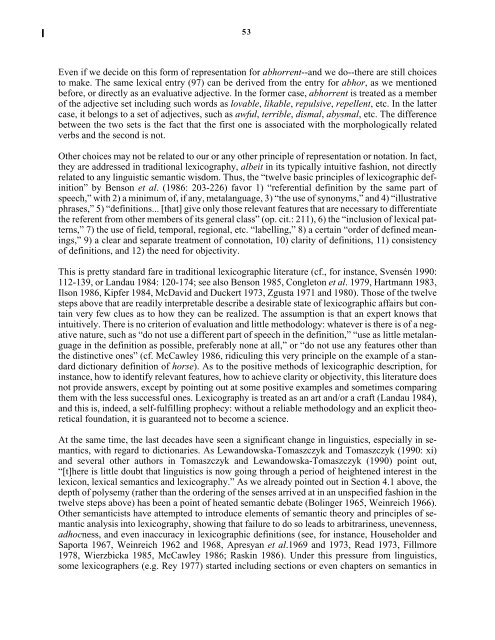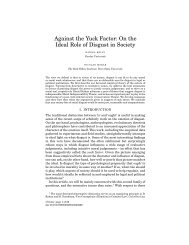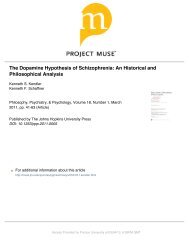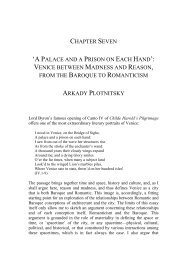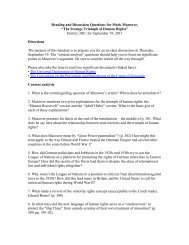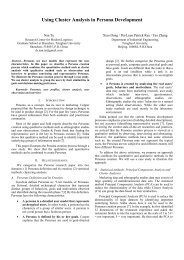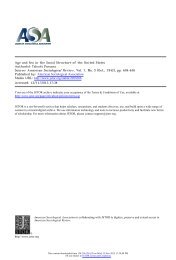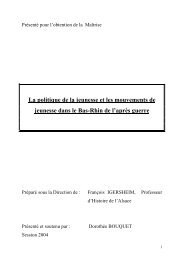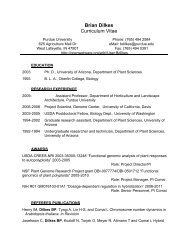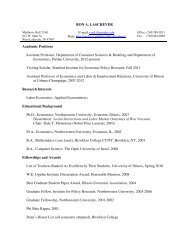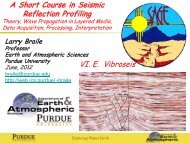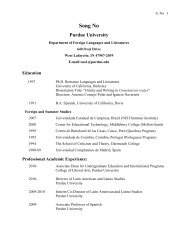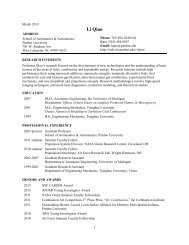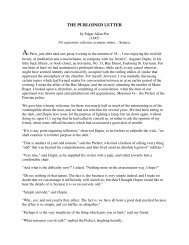Lexical Semantics of Adjectives - CiteSeerX
Lexical Semantics of Adjectives - CiteSeerX
Lexical Semantics of Adjectives - CiteSeerX
Create successful ePaper yourself
Turn your PDF publications into a flip-book with our unique Google optimized e-Paper software.
53<br />
Even if we decide on this form <strong>of</strong> representation for abhorrent--and we do--there are still choices<br />
to make. The same lexical entry (97) can be derived from the entry for abhor, as we mentioned<br />
before, or directly as an evaluative adjective. In the former case, abhorrent is treated as a member<br />
<strong>of</strong> the adjective set including such words as lovable, likable, repulsive, repellent, etc. In the latter<br />
case, it belongs to a set <strong>of</strong> adjectives, such as awful, terrible, dismal, abysmal, etc. The difference<br />
between the two sets is the fact that the first one is associated with the morphologically related<br />
verbs and the second is not.<br />
Other choices may not be related to our or any other principle <strong>of</strong> representation or notation. In fact,<br />
they are addressed in traditional lexicography, albeit in its typically intuitive fashion, not directly<br />
related to any linguistic semantic wisdom. Thus, the “twelve basic principles <strong>of</strong> lexicographic definition”<br />
by Benson et al. (1986: 203-226) favor 1) “referential definition by the same part <strong>of</strong><br />
speech,” with 2) a minimum <strong>of</strong>, if any, metalanguage, 3) “the use <strong>of</strong> synonyms,” and 4) “illustrative<br />
phrases,” 5) “definitions... [that] give only those relevant features that are necessary to differentiate<br />
the referent from other members <strong>of</strong> its general class” (op. cit.: 211), 6) the “inclusion <strong>of</strong> lexical patterns,”<br />
7) the use <strong>of</strong> field, temporal, regional, etc. “labelling,” 8) a certain “order <strong>of</strong> defined meanings,”<br />
9) a clear and separate treatment <strong>of</strong> connotation, 10) clarity <strong>of</strong> definitions, 11) consistency<br />
<strong>of</strong> definitions, and 12) the need for objectivity.<br />
This is pretty standard fare in traditional lexicographic literature (cf., for instance, Svensén 1990:<br />
112-139, or Landau 1984: 120-174; see also Benson 1985, Congleton et al. 1979, Hartmann 1983,<br />
Ilson 1986, Kipfer 1984, McDavid and Duckert 1973, Zgusta 1971 and 1980). Those <strong>of</strong> the twelve<br />
steps above that are readily interpretable describe a desirable state <strong>of</strong> lexicographic affairs but contain<br />
very few clues as to how they can be realized. The assumption is that an expert knows that<br />
intuitively. There is no criterion <strong>of</strong> evaluation and little methodology: whatever is there is <strong>of</strong> a negative<br />
nature, such as “do not use a different part <strong>of</strong> speech in the definition,” “use as little metalanguage<br />
in the definition as possible, preferably none at all,” or “do not use any features other than<br />
the distinctive ones” (cf. McCawley 1986, ridiculing this very principle on the example <strong>of</strong> a standard<br />
dictionary definition <strong>of</strong> horse). As to the positive methods <strong>of</strong> lexicographic description, for<br />
instance, how to identify relevant features, how to achieve clarity or objectivity, this literature does<br />
not provide answers, except by pointing out at some positive examples and sometimes comparing<br />
them with the less successful ones. Lexicography is treated as an art and/or a craft (Landau 1984),<br />
and this is, indeed, a self-fulfilling prophecy: without a reliable methodology and an explicit theoretical<br />
foundation, it is guaranteed not to become a science.<br />
At the same time, the last decades have seen a significant change in linguistics, especially in semantics,<br />
with regard to dictionaries. As Lewandowska-Tomaszczyk and Tomaszczyk (1990: xi)<br />
and several other authors in Tomaszczyk and Lewandowska-Tomaszczyk (1990) point out,<br />
“[t]here is little doubt that linguistics is now going through a period <strong>of</strong> heightened interest in the<br />
lexicon, lexical semantics and lexicography.” As we already pointed out in Section 4.1 above, the<br />
depth <strong>of</strong> polysemy (rather than the ordering <strong>of</strong> the senses arrived at in an unspecified fashion in the<br />
twelve steps above) has been a point <strong>of</strong> heated semantic debate (Bolinger 1965, Weinreich 1966).<br />
Other semanticists have attempted to introduce elements <strong>of</strong> semantic theory and principles <strong>of</strong> semantic<br />
analysis into lexicography, showing that failure to do so leads to arbitrariness, unevenness,<br />
adhocness, and even inaccuracy in lexicographic definitions (see, for instance, Householder and<br />
Saporta 1967, Weinreich 1962 and 1968, Apresyan et al.1969 and 1973, Read 1973, Fillmore<br />
1978, Wierzbicka 1985, McCawley 1986; Raskin 1986). Under this pressure from linguistics,<br />
some lexicographers (e.g. Rey 1977) started including sections or even chapters on semantics in


